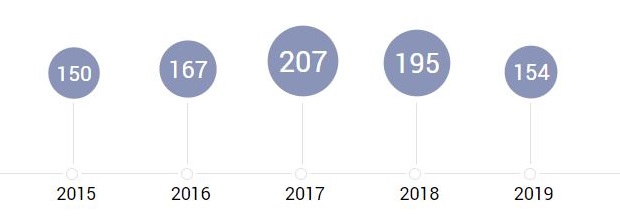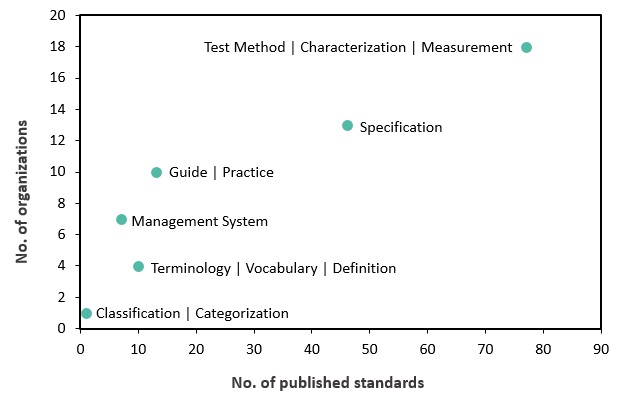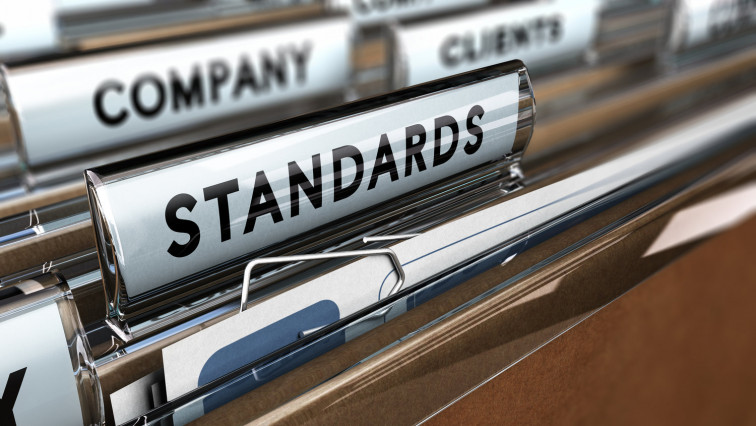According to StatNano, 1422 nanotechnology standards have been published by consensus and approved by 42 recognized bodies since 1992. A comparison of these standards over the past three years in Figure 1 shows a conspicuous drop in 2019 so that 154 standards were published, most of which were adopted by national organizations (ca., 77.9 %), and the rest were made available to the public by international (ca., 15.6 %) and regional (ca., 6.5 %) bodies, respectively.

Figure 1. The number of published nanotechnology standards between 2015 and 2019.
As shown in Table 1, the UK, Italy, Denmark, Austria, Spain, the Netherlands, Sweden, France, Belgium, Iran, Estonia, Finland, Russia, China, Bulgaria, Germany, Australia, and Norway were the pioneering countries in nano-related standards publications in the past year, paying particular attention to nanotechnology exploitation. Accordingly, 21 organization bodies of ISO, BSI, UNI, DS, ASI, CEN, AFNOR, NEN, SIS, AENOR, NBN, ISIRI, EVS, SFS, GOSTR, SAC, BDS, DIN, SA, IEC, and SN made the highest contributions to the standardization of nanotechnology-based products, services, and systems in 2019.
Table 1. Number of nanotechnology standards published by various organizations in 2019
|
No. |
Organization Level |
Organizations |
Countries |
No. of Standards |
|
1 |
International |
ISO |
World |
23 |
|
IEC |
1 |
|||
|
2 |
Regional |
CEN |
10 |
|
|
3 |
National |
BSI |
20 |
|
|
UNI |
17 |
|||
|
DS |
12 |
|||
|
ASI |
10 |
|||
|
AFNOR |
9 |
|||
|
NEN |
9 |
|||
|
SIS |
8 |
|||
|
AENOR |
7 |
|||
|
NBN |
5 |
|||
|
ISIRI |
4 |
|||
|
EVS |
4 |
|||
|
SFS |
4 |
|||
|
GOSTR |
3 |
|||
|
SAC |
2 |
|||
|
BDS |
2 |
|||
|
DIN |
2 |
|||
|
SA |
1 |
|||
|
SN |
1 |
It is worth mentioning that a broad spectrum of the published national standards were an adoption of either the regional or international bodies, among which EN 17199:2019 (parts 2-5), ISO/TS 21083:2019, ISO/TS 16195:2018, CEN/TS 17273:2018, CEN/TS 17274:2018, and CEN/TS 17275:2018 received the highest shares (Table 2).
Table 2. The most common standards from which 2019’s national standards were adopted
|
No. |
Standard No. |
Standard Title |
|
1 |
Workplace exposure - Measurement of dustiness of bulk materials that contain or release respirable NOAA or other respirable particles - Part 2: Rotating drum method |
|
|
2 |
Workplace exposure - Measurement of dustiness of bulk materials that contain or release respirable NOAA or other respirable particles - Part 3: Continuous drop method |
|
|
3 |
Workplace exposure - Measurement of dustiness of bulk materials that contain or release respirable NOAA or other respirable particles - Part 4: Small rotating drum method |
|
|
4 |
Workplace exposure - Measurement of dustiness of bulk materials that contain or release respirable NOAA or other respirable particles - Part 5: Vortex shaker method |
|
|
5 |
Test method to measure the efficiency of air filtration media against spherical nanomaterials - Part 2: Size range from 3 nm to 30 nm |
|
|
6 |
Nanotechnologies - Specification for developing representative test materials consisting of nano-objects in dry powder form |
|
|
7 |
Nanotechnologies - Guidance on detection and identification of nano-objects in complex matrices |
|
|
8 |
Nanotechnologies - Guidelines for determining protocols for the explosivity and flammability of powders containing nano-objects (for transport, handling and storage) |
|
|
9 |
Nanotechnologies - Guidelines for the management and disposal of waste from the manufacturing and processing of manufactured nano-objects |
|
|
10 |
Test method to measure the efficiency of air filtration media against spherical nanomaterials - Part 1: Size range from 20 nm to 500 nm |
|
|
11 |
Nanotechnologies - Sample preparation for the characterization of metal and metal-oxide nano-objects in water samples |
|
|
12 |
Nanotechnologies - Health and safety practices in occupational settings |
|
|
13 |
Nanotechnologies - Considerations for the measurement of nano-objects and their aggregates and agglomerates (NOAA) in environmental matrices |
|
|
14 |
Textile products and nanotechnologies - Guidance on tests to simulate nanoparticle release - Skin exposure |
These standards fell into six different categories, 48.3 % of which were included in the Test Method| Characterization| Measurement category. Specifications ranked second with around 30.9 %, and the Guide|Practice, Terminology| Vocabulary| Definition, Management System, and Classification| Categorization categories took the next places, having approximately 8.7, 6.7, 4.7, and 0.7 %, respectively, as shown in Figure 2. Most of these standards aim to ensure the risks of the workplace exposure of nano-objects (e.g., nanoparticles, nanopowders, and nanosuspensions) in the chemical industrial sector, more especially in catalysts, paints, and resins production. In addition, such carbon-based structures as carbon black, carbon nanotubes, and graphene are the most common nanomaterials discussed in these standards.

Figure 2. Number of published nanotechnology standards and organization bodies in each standard category.
Source
Statnano Nanotechnology Standards Database


